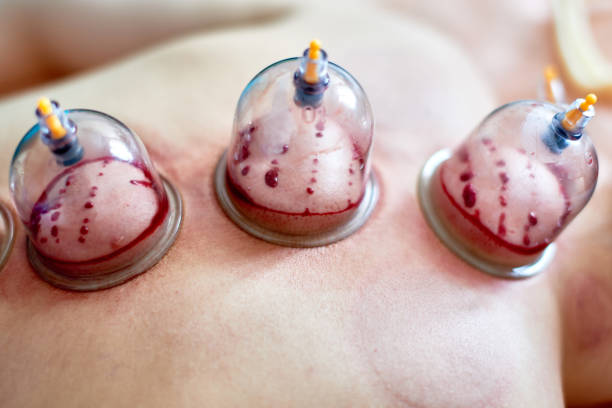Benefits of Cupping Therapy/Hijama Therapy?
What is Cupping Therapy?
Cupping therapy is an ancient form of alternative medicine where special cups are placed on your skin to create suction This suction can be generated by heat, a pump, or manual pressure. The idea is to draw blood to or away from specific parts of your body.
Types of Cupping Therapy:
- Dry Cupping: Cups are heated with fire or a flame before being placed on the skin. As the air inside the cup cools, a vacuum is created, drawing the skin upward. Also, a pump can also be used to create a suction without the use of fire.
- Wet Cupping/Hijama Cupping: This involves making small incisions on the skin before placing the cups. The suction draws out a small amount of blood.
- Smart Cupping: This uses advanced mechanical cups to create a dynamic suction effect.
Benefits: Advantages or Positive Outcomes
Benefits are the positive effects or advantages that come from something. They can be tangible or intangible.
Benefits of Cupping Therapy (Hijama Therapy)
10 Benefits of Cupping Therapy (Hijama Therapy) Explained
1. Pain Relief
- Mechanism: Cupping increases blood flow to the affected area, which can help reduce inflammation and muscle tension.
- Benefits: Effective for conditions like back pain, neck pain, arthritis, and headaches.
2. Improved Blood Circulation
- Mechanism: The suction created by the cups draws blood to the surface, improving circulation and oxygen delivery to tissues.
- Benefits: Can help with cold extremities, fatigue, and overall well-being.
3. Relaxation and Stress Reduction
- Mechanism: Cupping can induce a deep state of relaxation, helping to relieve stress and anxiety.
- Benefits: Promotes mental clarity and emotional balance.
4. Reduced Inflammation
- Mechanism: Increased blood flow and removal of toxins can help reduce inflammation in the body.
- Benefits: Can alleviate symptoms of conditions like arthritis and asthma.
5. Skin Improvement
- Mechanism: Increased blood flow can promote skin regeneration and healing.
- Benefits: May improve skin tone, texture, and reduce acne.
6. Respiratory Benefits
- Mechanism: By improving blood circulation and clearing congestion, cupping can help with respiratory issues.
- Benefits: Can alleviate symptoms of asthma, bronchitis, and allergies.
7. Digestive Relief
- Mechanism: Cupping can stimulate the digestive system and improve organ function.
- Benefits: May help with constipation, bloating, and indigestion.
8. Immune System Boost
- Mechanism: Increased blood circulation and removal of toxins can strengthen the immune system.
- Benefits: Helps the body fight off infections and diseases.
9. Detoxification
- Mechanism: Cupping helps remove toxins and waste products from the body.
- Benefits: Can improve overall health and well-being.
10. Mental Well-being
- Mechanism: Relaxation, pain relief, and improved circulation contribute to better mental health.
- Benefits: Can alleviate symptoms of depression and anxiety.
Contraindications: Reasons to Avoid:
Absolute Contraindications:
- Cancer: Until more research is available, cupping is generally contraindicated for cancer patients.
- Organ failure: Conditions like kidney, liver, or heart failure are absolute contraindications.
- Pacemaker: The suction created by cupping can interfere with the pacemaker’s function.
- Hemophilia: Due to the risk of bleeding, cupping is not recommended for people with hemophilia.
Relative Contraindications:
- Acute infections: Cupping may not be suitable for individuals with active infections.
- Anticoagulant use: Patients on blood-thinning medications should avoid cupping due to the increased risk of bleeding.
- Severe chronic diseases: Conditions like severe heart disease may be relative contraindications.
- Pregnancy and postpartum: While some practitioners may perform cupping during pregnancy, it’s generally recommended to avoid it, especially in the first trimester.
- Menstruation: Some practitioners advise against cupping during menstruation.
- Anemia: Individuals with low red blood cell count should exercise caution.
- Recent wet cupping or blood donation: Allow sufficient time for the body to recover.
- Medical emergencies: Cupping is not suitable for individuals in critical condition.
Other Considerations:
- Skin conditions: Avoid cupping on areas with open wounds, skin infections, or burns.
- Varicose veins: Direct cupping on varicose veins is generally not recommended.
- Osteoporosis: Care should be taken when performing cupping on elderly individuals with osteoporosis.
Indications:
Pain Management
- Musculoskeletal pain: Back pain, neck pain, shoulder pain, and joint pain
- Headaches and migraines: Can provide temporary relief
Circulatory Issues
- Poor circulation: Can improve blood flow to the affected area
- Cold extremities: May help warm up hands and feet
Skin Conditions
- Acne: Some people believe cupping can help improve skin condition
- Cellulite: While evidence is limited, it is sometimes used for this purpose
Other Conditions
- Digestive issues: May help with bloating and indigestion
- Fatigue: Some people report increased energy levels after cupping

